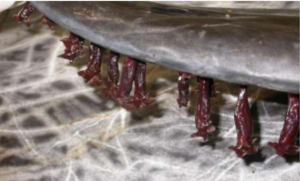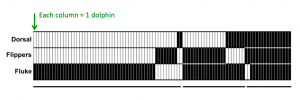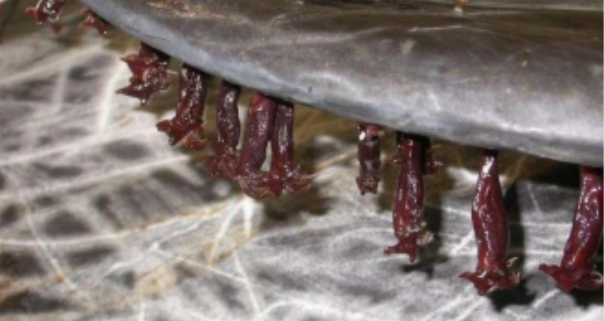Living on the Edge: Settlement Patterns by the Symbiotic Barnacle Xenobalanus globicipitis on Small Cetaceans
By Rachel Skubel, RJD Intern
If you were a barnacle, how would you choose your home? For X. globicipitis barnacles residing on striped dolphins, this question was ‘put under the microscope’ by Juan Carillo and colleagues at the University of Southern Mississippi and Cavanilles Institute of Biodiversity and Evolutionary Biology (Valencia, Spain).
Of all obligate barnacles studied, X. globicipitis has been found on animals that experience the most intense currents (Bearzi and Patonai, 2010). These organisms will settle on dolphins to optimize for (a) availability of passing current, to provide food, and (b) low drag from said current, to reduce physical degradation of the animal. Here, the investigators asked the following questions:
- Where do these barnacles choose to settle?
- How does this choice affect the barnacles’ recruitment (define), survival, and growth?
The researchers examined stranded striped dolphins (Stenella coerleoalba) along 556 km of the spanish mediterranean coastline (map), from 1979 to 2009. In 1990 and 2007, many of the dolphins examined had been killed by the morbillivirus (link to http://www.nmfs.noaa.gov/pr/health/mmume/midatlantic2013/morbillivirus_factsheet2013.pdf) – infected animals would have swam slower and had weaker immune systems than otherwise, making them more likely to be colonized by the barnacles. For each animal, the researchers looked at the abundance (i.e. amount), location, and size of the barnacles. Then, they used a model to investigate why barnacles were colonizing certain locations of the dolphins.

Figure 1: Barnacles were mainly found on the trailing edges of dorsal fins, flippers, and flukes, over an area ~2cm wide (Dr. Mariano Domingo, Autonomous University of Barcelona, Spain)
Results
Out of 242 dolphins examined, 104 had the X. globicipitis barnacles – on either their dorsal fins, flippers, and tail flukes. Of these locations, the tail flukes were by far the most common. Even if the dolphins had barnacles in multiple locations, linear density (barnacles/cm) was significantly higher on the tail. Also, the shell size of barnacles on the flukes was higher than on the flippers and dorsal fins. For these dolphins with barnacles on their tail flukes, it was more common to find them on the dorsal (top) than ventral (bottom) size of the tail.

Figure 2: When dolphins were found with X. globicipitis barnacles, they were most likely on the caudal fin.
Dolphins thought to have died from the morbillivirus did not have any significant differences in where the barnacles were located, or their size, compared to the unaffected animals.
Explaining the trends
When interpreting these results, it was important to consider that these were all pre-deceased study subjects, and the barnacles might have even settled on the carcasses. However, the finding of tail flukes being a popular settlement area for these barnacles matches with observations in the wild (see video below).
https://www.youtube.com/watch?v=8aJdW5IRZSs
Beginning around 0:13, you can see barnacles are common on the tails of wild dolphins, supporting the findings of the present study by Carillo et al.
How do the barnacles choose where to dig in? The researchers propose that once they’ve used chemical cues to recognize the dolphins as proper hosts, a two-pronged mechanism follows.
- First, attachment success: those that choose the tail to latch onto will be less likely to fall off in the process because there is some shelter from strong currents. And once one barnacle settles, it actually becomes easier for more to do the same because they will be ‘sheltered’ by this first individual.
- Second, there is less early cyprid mortality, which means that once fully attached, it is easier to stay attached.
Lastly, the authors considered why there were more barnacles on the dorsal sides of the tails. This could be due to an asymmetrical swimming style by the dolphins, which means that their ‘downstroke’ is stronger than their ‘upstroke’, so there is less force on the settled barnacles if they settle on the top of the tail. However, whether the swimming style of these dolphins is symmetrical or assymetrical is not conclusively known.
References
Bearzi M, Patonai K (2010). Occurrence of the barnacle (Xenobalanus globicipitis) on coastal and offshore common bottlenose dolphins (Tursiops truncatus) in Santa Monica Bay and adjacent areas, California. Bull South Calif Acad Sci. 109: 37–44. DOI: 10.3160/0038-3872-109.2.37
Carrillo JM, Overstreet RM, Raga JA, Aznar FJ (2015) Living on the Edge: Settlement Patterns by the Symbiotic Barnacle Xenobalanus globicipitis on Small Cetaceans. PLoS ONE 10(6): e0127367. DOI: 10.1371/journal.pone.0127367




Leave a Reply
Want to join the discussion?Feel free to contribute!